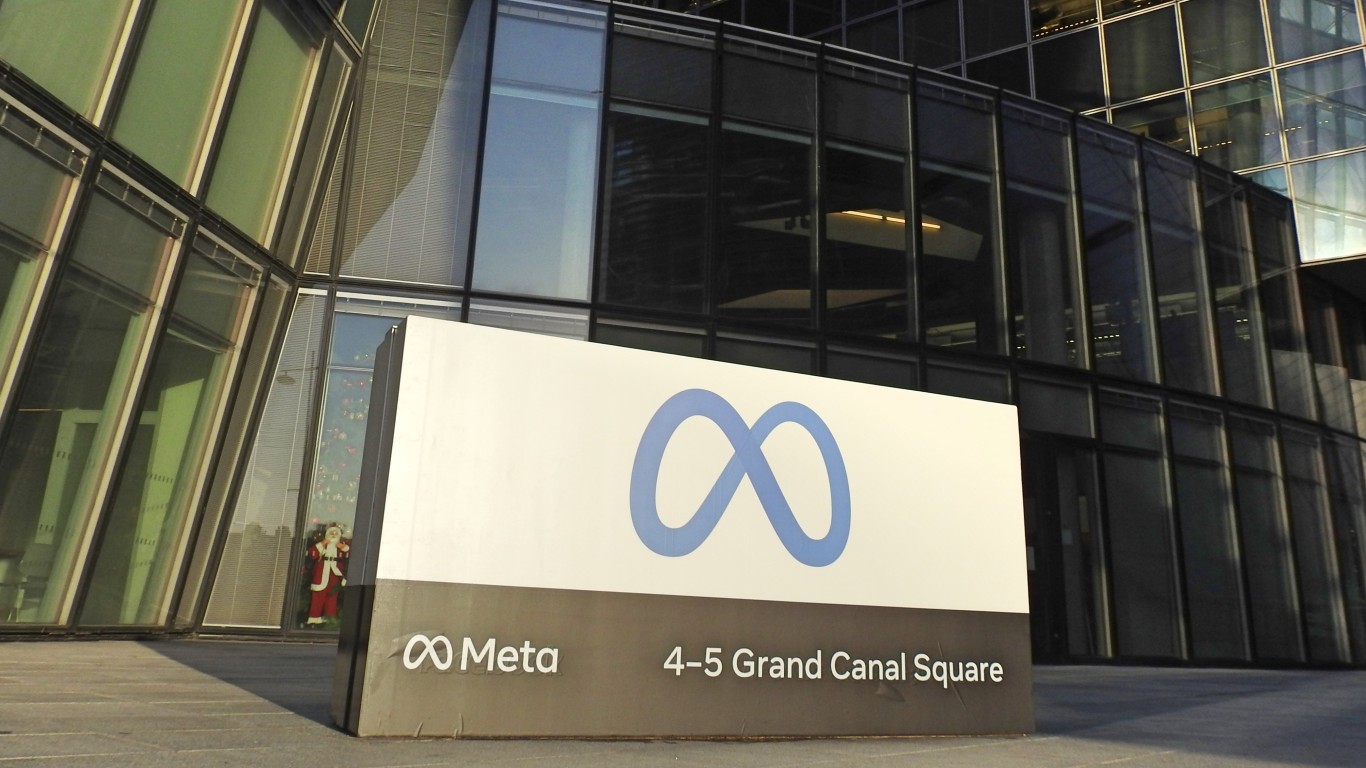Investing
Meta Stock Price Prediction in 2030: Bull, Base & Bear Forecasts

Published:
Last Updated:

Meta Platforms, the company formerly known as Facebook, has seen its share price whipsawed over the past couple years. After peaking above $380 in September 2021, the stock plunged nearly 60% to below $160 in November 2022. It has since rallied to around $475.
Where is Meta stock heading in the long run? As a 20-year old company that just initiated its first-ever dividend, Meta takes a founder-CEO’s long view. 39-year-old Mark Zuckerberg is focused on the next decade, not next quarter.
247 Wall St. evaluates bullish, base case and bearish scenarios for Meta in 2030 based on financial metrics and growth drivers…
The bull case hinges on Meta leveraging its massive R&D budget to crack augmented reality glasses and the metaverse. Meta Reality Labs segment revenue jumped 31% last quarter, while operating losses approached $4.3 billion. However, if Meta becomes the Apple of AR glasses or the Nvidia of the metaverse, its growth and profit potential is immense.
In the bull case, Meta grows revenue at a 15% CAGR to around $240 billion in 2030. With 40% net margins, it would earn $96 billion, or $38 per share. Applying a P/E ratio of 35x, comparable to top cloud stocks today, yields a $1,330 stock price. Just a 10% metaverse market share with 30% margins could contribute another $10+ in earnings power.
The base case assumes Meta’s core digital advertising business rebounds from macro pressures today. Meta dominates digital advertising alongside Alphabet with over 50% market share.
Meta’s Q4 ad revenue grew just 3% year-over-year. But it expects a return to double-digit growth this year. Consensus forecasts call for 11% growth in 2023 and 14% annual growth from 2023-2025.
If Meta grows revenue at 12% annually to $140 billion and expands net margins to 40% by 2030, it would earn $56 billion, or $20 per share with stock buybacks. Applying a Price/Earnings multiple of 19 which approximately the S&P 500’s historic average, yields a $380 share price.
The bear case risk is that Meta fails to evolve its social/ad platforms or build a new growth engine in time. As the Facebook app loses teenage engagement, Meta relies more on Instagram. But newer apps like TikTok and BeReal keep gaining ground. If competition erodes engagement and monetization over time, Meta’s growth could fade to less than 5% annually. Slower growth plus sustained Reality Labs losses would substantially mute earnings. Meanwhile, Meta has spent $36 billion on metaverse R&D since 2020. Those costs continue ballooning with no clarity if/when they pay off financially.
In the bear case we assume mid-single digit annual growth, 30% margins and a lower market multiple of 8. That combination gets Meta to around $100 per share or below in 2030.
Meta’s growth and margins over the next decade depend hugely on sustaining user engagement, especially on mobile devices. While the Facebook app is saturated, Instagram and WhatsApp have billions more potential users worldwide.
Monetizing messaging and private sharing on those apps is key, along with succeeding in commerce and payments. Meta is aggressively building business messaging, CRM tools, social shopping features and facilitating payments via Novi wallet and Diem blockchain (recently sold) projects. Monetizing messaging and private sharing on these apps is crucial, along with success in commerce and payments. Meta is aggressively building business messaging, CRM tools, social shopping features, and facilitating payments via Novi wallet and blockchain initiatives.
Of course, realizing the metaverse’s full potential to enable presence and connect virtually via augmented or virtual reality is Meta’s biggest moonshot. Mark Zuckerberg believes the metaverse will be the next major computing platform after mobile. Meta plans to monetize its metaverse similarly to mobile today – via digital advertising, paid virtual items/experiences and creator/developer fees.
For 2022, Meta grew revenue by 4% to $116.6 billion. It earned $23.2 billion in net income, down 41%. However, Reality Labs operating losses approached $13.7 billion. Excluding R&D investments, Meta’s core Family of Apps generated 49% operating margins last year. Margins expanded despite foreign exchange headwinds and declining ad yields.
Its balance sheet remains rock solid with $40 billion in cash and investments against just $11 billion in debt. Meta produces over $46 billion in annual free cash flow, enabling heavy R&D and capital returns.
Management initiated a $0.50 per share quarterly dividend in Q4, translating to $3.5 billion annually. Meta also has $81 billion remaining on its buyback authorization.
After plunging to just 12x forward earnings last Fall, Meta has rebounded 25% along with tech stocks broadly in 2023. Meta now trades at 15x forward earnings with a 16x PEG ratio. Meanwhile, Meta dominates communication and digital advertising alongside Google. And it continues placing moonshot bets in the future of computing. For long-term investors, Meta remains a high risk, high reward play on mobile messaging monetization and realizing the full potential of augmented/virtual reality technology in the 2030s. To learn more about technology and R&D, check out The Best States for Science and Tech: All 50 States Ranked.
Credit card companies are pulling out all the stops, with the issuers are offering insane travel rewards and perks.
We’re talking huge sign-up bonuses, points on every purchase, and benefits like lounge access, travel credits, and free hotel nights. For travelers, these rewards can add up to thousands of dollars in flights, upgrades, and luxury experiences every year.
It’s like getting paid to travel — and it’s available to qualified borrowers who know where to look.
We’ve rounded up some of the best travel credit cards on the market. Click here to see the list. Don’t miss these offers — they won’t be this good forever.
Thank you for reading! Have some feedback for us?
Contact the 24/7 Wall St. editorial team.